Plant Tissues and Organs
Plant Tissues and Organs Revision
Plant Tissues and Organs
Like animals, plants are made of various types of specialised cells that work together to form tissues. Tissues work together to form organs that together make up whole organ systems. Substances are transported around the plant in an organ system that consists of the roots, stem and leaves. A stream of water is continuously transported up the plant due to the constant loss of water from the leaves (transpiration).
Structure of Leaves and Plant Tissues
Leaves are plant organs responsible for the majority of photosynthesis and gas exchange. The structuring of the different tissues in a leaf mean they are adapted for these functions.
- The epidermal tissues are found on the top and bottom of the leaf. They are covered with a waxy cuticle to prevent water loss from the leaf by evaporation. The upper epidermis is transparent and very thin to allow light to pass through into the palisade layer (where the majority of photosynthesis takes place). The lower epidermis is full of little holes called stomata that allow gases to diffuse in and out of the cell. Guard cells open and close the stomata in response to environmental conditions.
- The palisade mesophyll tissue is near the top of the leaf and has lots of chloroplasts so is able to absorb lots of light for photosynthesis.
- The spongy mesophyll tissue has lots of air spaces which provide space for gases to diffuse in and out of the cell.
- The xylem and phloem tissues supply the leaf with water and nutrients required by the cells and remove glucose produced by the leaf in photosynthesis.
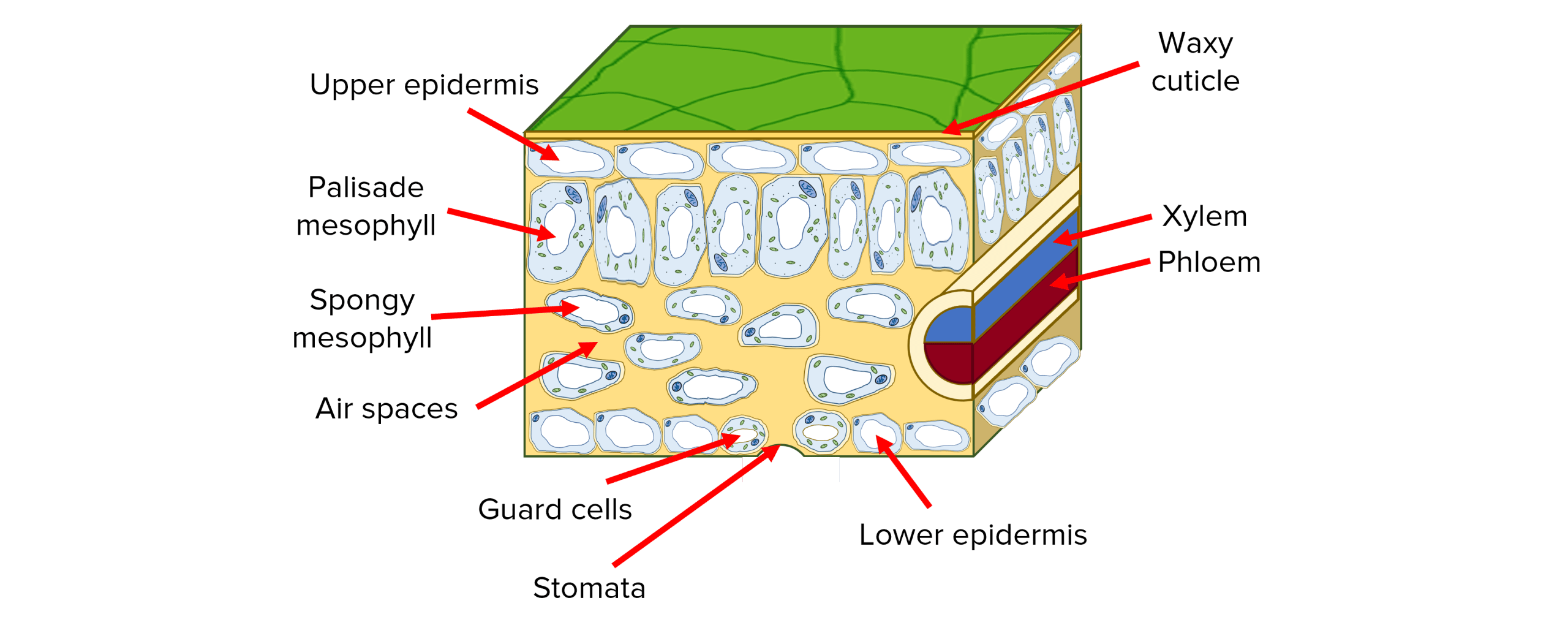
Meristem tissue is found at the tips of shoots and roots and contains plant stem cells which enable the plant to create new cells for growth and repair.
Phloem
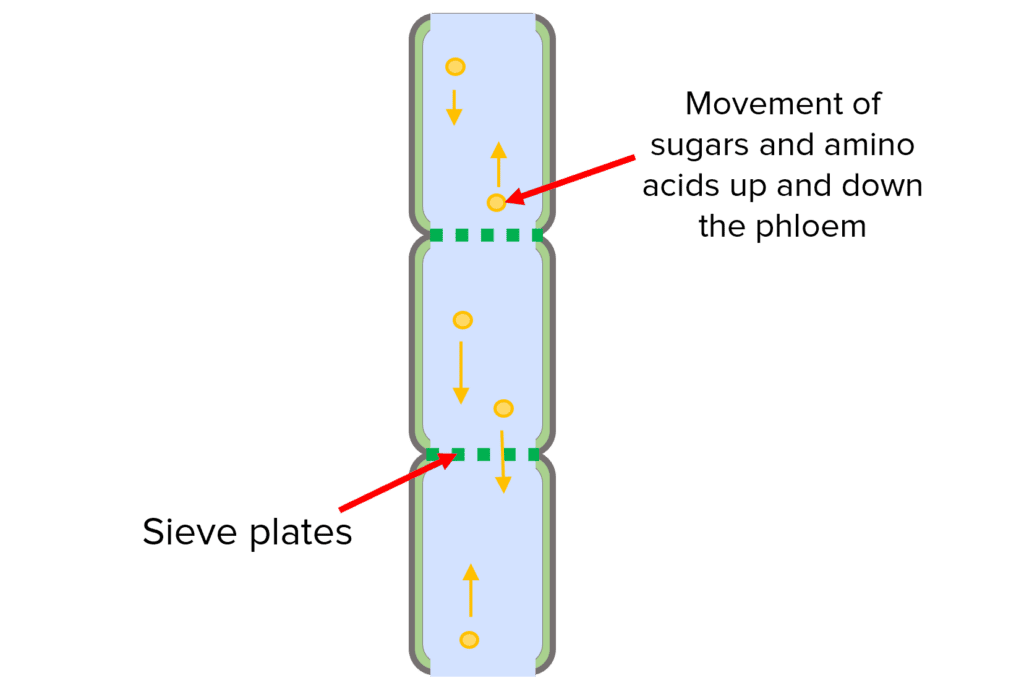
Cells of the phloem are specialised to provide efficient transport of food substances, such as sugars and amino acids, around the the plant (mainly from the leaves to the stems and roots):
- The cells are elongated and join end to end with sieve plates in between them. Sieve plates have pores that allow cell sap to flow through.
- The cells are living but have very few subcellular structures so substances can pass through easily.
- Substances can move both directions in the vessel so they can get to where they are most needed.
The phloem is important for providing food substances to areas of the plant that do not photosynthesise, where they can be stored or used immediately.
The process of moving food substances in the phloem is called translocation.
Xylem
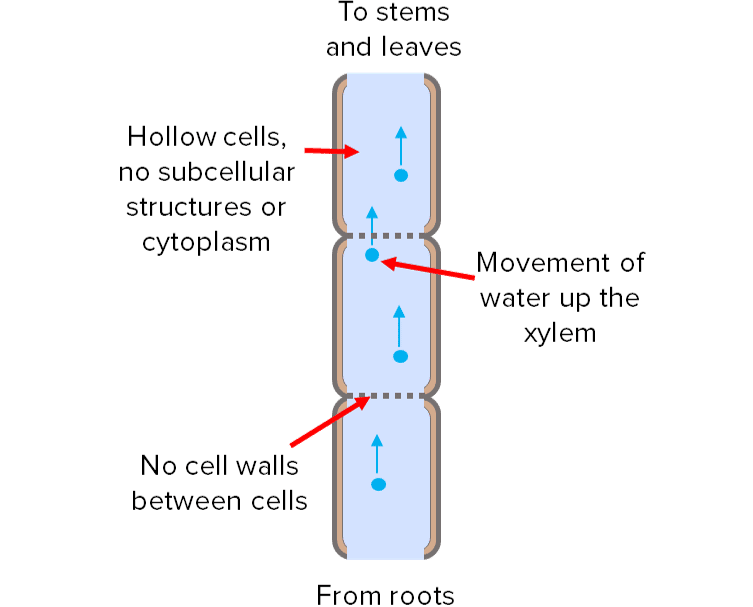
Cells of the xylem are specialised to provide efficient transport of water and dissolved mineral ions up the plant, from the roots to the stems and leaves:
- The top and bottom of the cells have no cell walls so they can join together to form the xylem vessel.
- The xylem cells are dead, hollow and contain no subcellular structures or cytoplasm.
- Xylem vessels are strengthened by lignin.
Water is drawn up the plant in the transpiration stream.
What is Transpiration?
Transpiration is the loss of water from a plant’s surface and it creates a constant flow of water through the plant called the transpiration stream:
- Most transpiration happens in leaves. Water diffuses and evaporates out into the atmosphere which creates a shortage in the leaf.
- Water is drawn up the xylem and into the leaves to replace the lost water.
- This means more water is drawn up from the soil, into the roots. Roots have specialised cells, called root hair cells, that are adapted for efficient uptake of water by osmosis and mineral ions by active transport.
The water exits the leaf through pores called stomata that are controlled by guard cells.
Stomata and Guard Cells
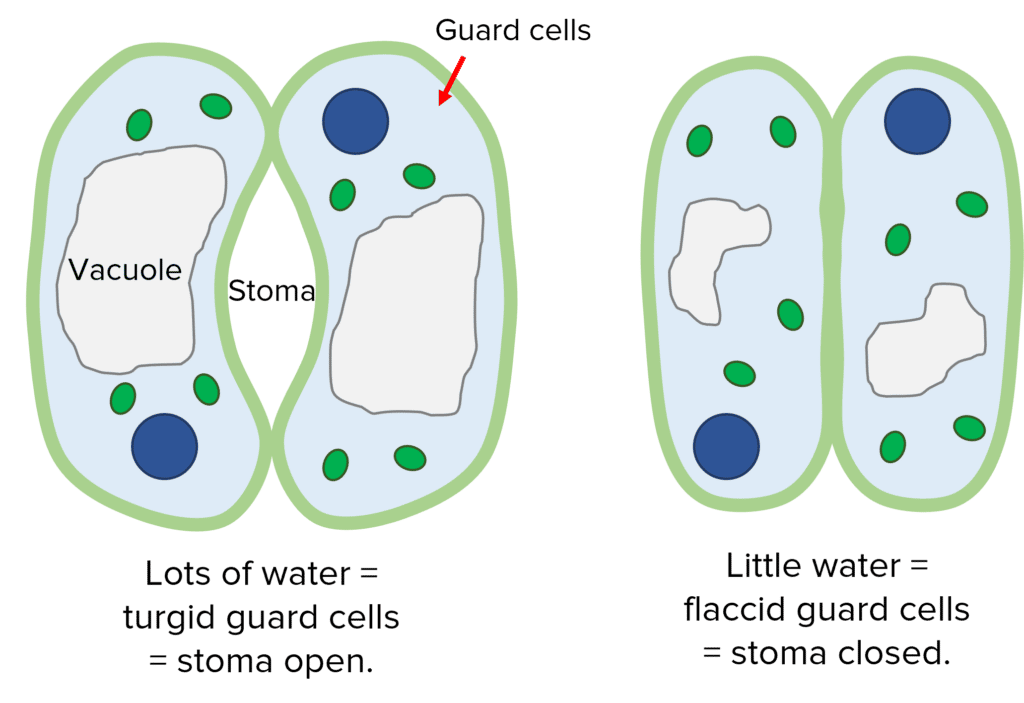
Guard cells control gas exchange and water loss from the leaf by opening and closing pores on the underside of the leaf called stomata.
- When there is lots of water in the plant, the guard cells fill with water and become turgid. This opens the stomata, allows gases to be exchanged with the atmosphere and water to escape.
- When there is little water in the plant, the guard cells lose water and become flaccid. This closes the stomata and prevents too much water escaping.
Guard cells are also sensitive to light. In the day, they open to allow carbon dioxide to enter the leaf for photosynthesis. When it is dark, plants cannot photosynthesise so guard cells close the stomata to prevent excess water loss.
Transpiration Rate
The rate of transpiration is dependent on different factors:
- Temperature– The higher the temperature, the more the molecules move. This means more water evaporates from cell surfaces and diffuses out of the leaf which increases the rate of transpiration.
- Humidity– The lower the humidity, the lower the concentration of water outside of the leaf. This means there is a steeper concentration gradient, water will diffuse out of the leaf faster and therefore the transpiration rate will increase.
- Air movement– Increased air flow around the leaf also decreases the concentration of water outside the leaf, increasing the concentration gradient and rate of transpiration.
- Light intensity– In light, the guard cells become turgid and open the stomata. This increases water loss and the transpiration rate.
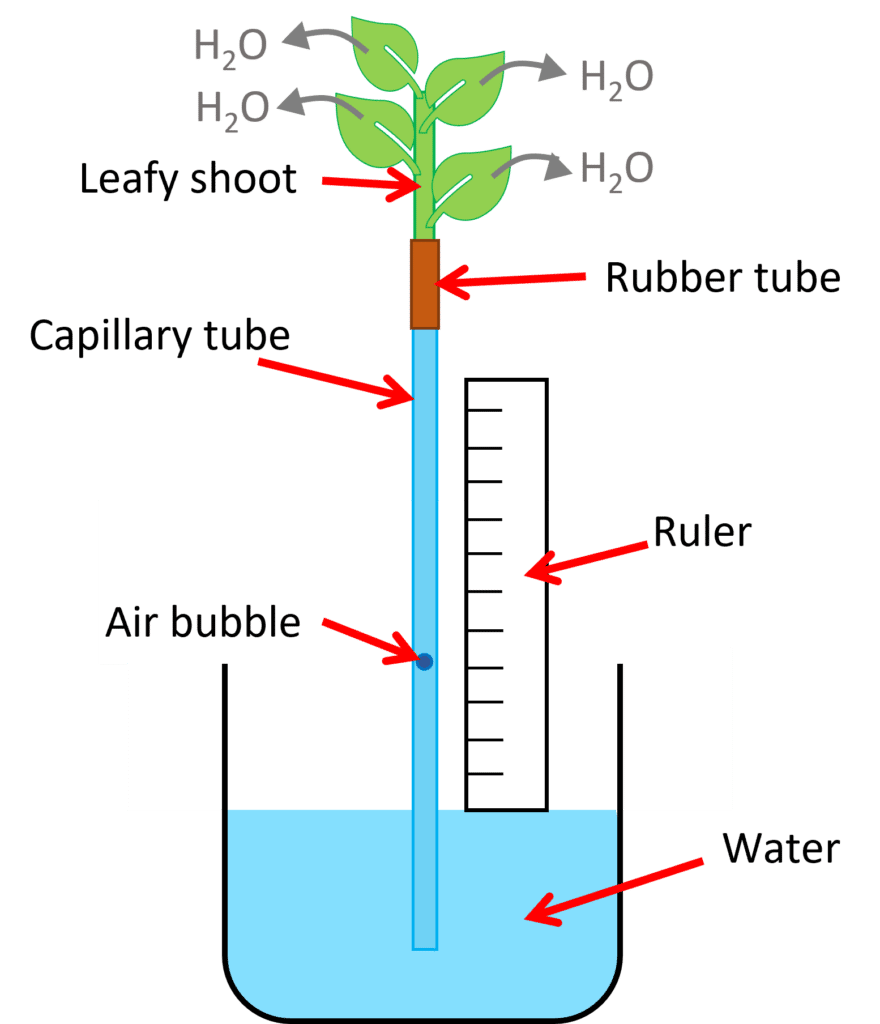
To find the rate of transpiration of a plant, you need to work out how much water is lost from the plant in a certain time frame. This can be quite hard to measure so instead you can assume that the amount of water lost from transpiration is equal to the amount of water taken in .
A potometer can be used to measure the water intake of a plant shoot (pictured on the right)
As water is lost from the shoot by transpiration, more water is drawn into the plant and the air bubble moves through the capillary tube.
By measuring the start and end position of the air bubble after a certain amount of time, you will be able to calculate the rate of bubble movement and hence the rate of transpiration.
\text{Rate of transpiration} = \dfrac{\text{Distance moved by bubble}}{\text{Time}}
Plant Tissues and Organs Example Questions
Question 1: Explain how the palisade mesophyll tissue is adapted for efficient photosynthesis.
[2 marks]
- It is near the top of the leaf and has lots of chloroplasts.
- This means it can absorb lots of light for photosynthesis.
Question 2: Give 3 differences between xylem and phloem vessels.
[6 marks]
Any 3 comparative statements:
- Xylem transports water and mineral ions whereas the phloem transports food substances.
- Xylem only transports molecules up the plant (one way) but phloem vessels transport molecules all around the plant (moves both ways).
- Xylem cells are dead, phloem cells are living.
- Xylem cells have no cell walls at the top and bottom to allow substances to pass through, phloem cells have sieve plates between cells to allow substances to pass through.
- Xylem cells have no subcellular structures, phloem cells have a few.
- Xylem is involved in transpiration, phloem is involved in translocation.
- Xylem vessels are strengthened by lignin, phloem vessels are not.
Question 3: Explain how and why stomata open in the day and close at night.
[5 marks]
- In the day, it is light and the guard cells gain water so become turgid, opening the stomata.
- This allows carbon dioxide to enter the cell for photosynthesis and oxygen diffuses out.
- At night, it is dark, so plants cannot photosynthesise.
- The guard cells lose water and become flaccid, closing the stomata.
- This prevents excess water loss.
Plant Tissues and Organs Worksheet and Example Questions
Plant Tissues and Organ Systems Questions
GCSEOfficial MME
MME Premium Membership
£19.99
/monthLearn an entire GCSE course for maths, English and science on the most comprehensive online learning platform. With revision explainer videos & notes, practice questions, topic tests and full mock exams for each topic on every course, it’s easy to Learn and Revise with the MME Learning Portal.
Sign Up Now





